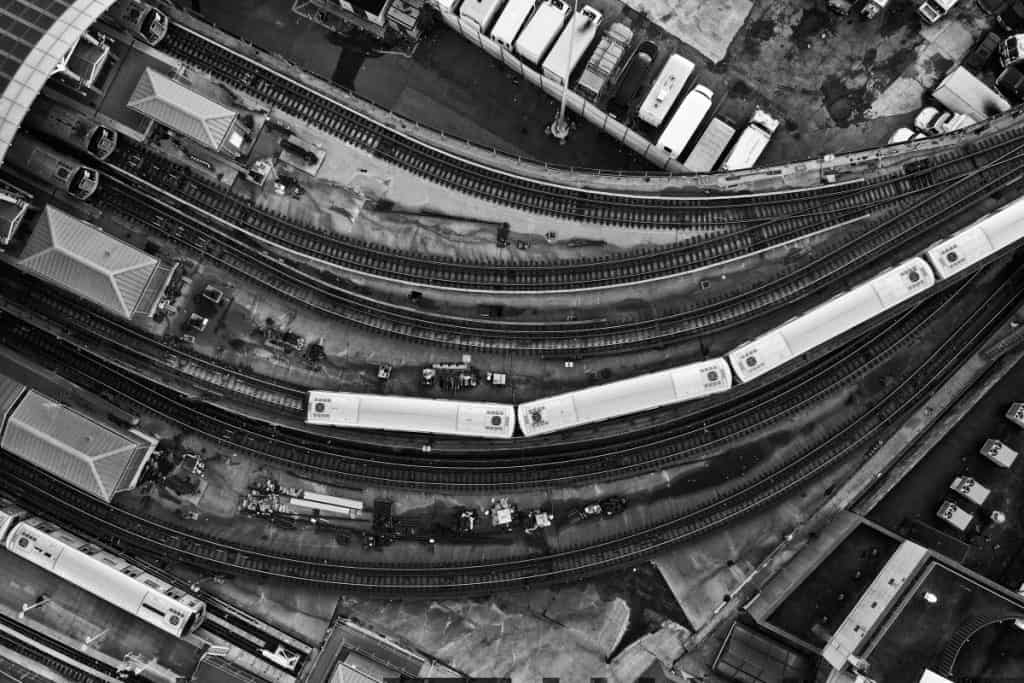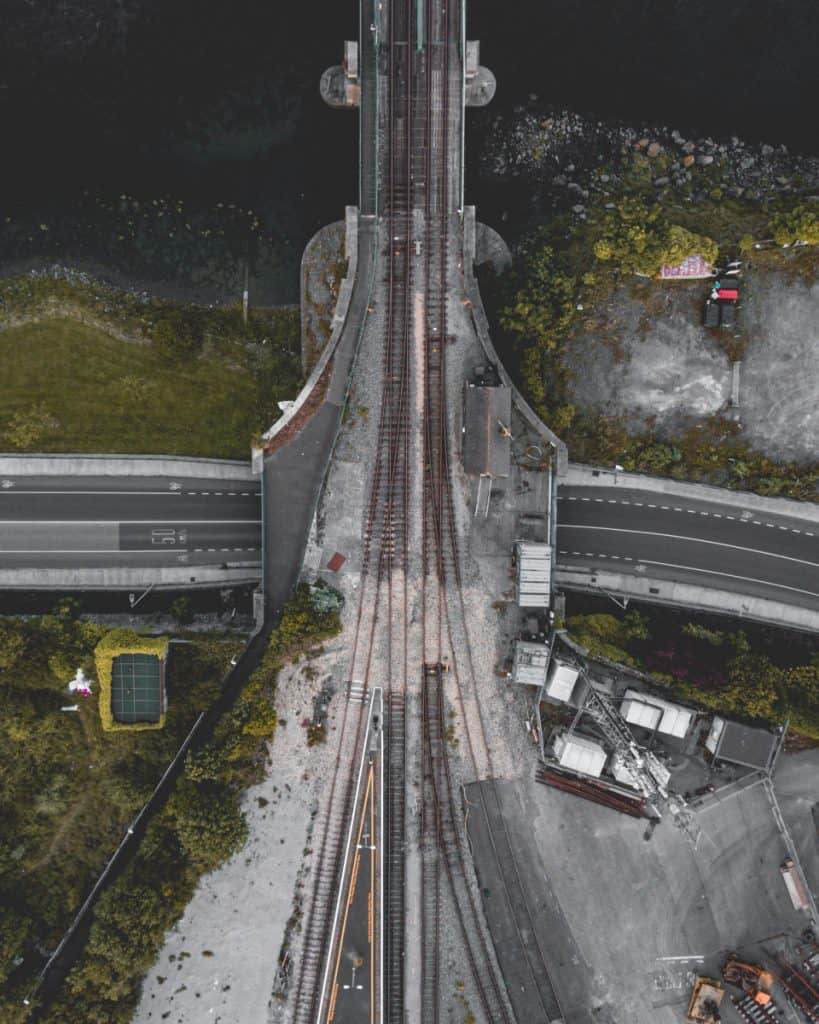There are plenty of times where I have considered flying my drone over railway tracks. Railroad tracks are perfect for drug photography as they provide an excellent contrast to the natural environment. They are also typically long, interesting, and moving vehicles that allow you to inject some character into photos videos. They also tend to be remote places that are perfect for flying your drone. But – can you fly a drone over railway tracks legally.
In many countries, you are not able to fly your drone over railway tracks. Railroad tracks are typically assigned as sensitive areas, and flying over railway tracks is considered illegal. Since the law is catching up slowly, a few grey areas may allow you to fly over railway tracks.
In many developed countries, there is an agreement on the fact that railway infrastructure is considered sensitive. In 2017 the infrastructure report card said that there were almost 140,000 miles of railroad tracks in the US – this makes it very tempting for drone pilots.

Most governments have created sensitive zones and areas for drone flying, which creates a no-fly zone around areas the government wants to protect.
Geo-fencing uses GPS and navigational satellite signals to automatically prevent drones from flying over airports, nuclear power plants, prisons, high profile events, and other secure areas as deemed by the government. At the moment, railway tracks are not strictly designated sensitive areas.
If you have a DJI drone, there are several zones in the DJI fly safe system, including:
- restricted zones – In these Zones, which appear red the DJI GO app, users will be prompted with a warning and flight is prevented. If you believe you have the authorization to operate in a Restricted Zone, please contact [email protected] or Online Unlocking.
- Altitude zones – Altitude zones will appear in grey on the map. Users receive warnings in DJI GO or DJI GO 4, and flight altitude is limited.
- Authorization zones – In these Zones, which appear blue in the DJI GO map, users will be prompted with a warning and flight is limited by default. Authorization Zones may be unlocked by authorized users using a DJI verified account.
- Warning zones – In these Zones, which may not necessarily appear on the DJI GO map, users will be prompted with a warning message. Example Warning Zone: Class E airspace
- enhanced warning zones – In these Zones, you will be prompted by GEO at the time of flight to unlock the zone using the same steps as in an Authorization Zone, but you do not require a verified account or an internet connection at the time of your flight.
- Regulatory restricted zones – Due to local regulations and policies, flights are prohibited within the scope of some special areas such as prisons.
- Recommended flight zone – This area is shown in green on the map. It is recommended that you choose these areas for flight arrangements.
If you come up to a Geofenced no-fly zone, the drone will not move any further and hover until it runs out of battery and lands.
Here are a few examples of what has happened in the UK and America around flying drones over railway tracks. These are examples that I have been able to find from clarifications of laws from drone enthusiasts and official sources such as railway networks and laws.
Examples from around the world
I have found that the United States of America, the UK, Canada, and Australia, have relatively well defined and developed drone laws. If I doubt what I can and cannot do with my drone, I often check these countries for guidance.
In the UK, as drone laws quickly catch up to the realities of drone technology, there has been a little bit of confusion about what you can do with your drone near railway tracks.
UK
Network Rail has stated that it can be illegal to fly a drone on or near a railway in the UK. A drone can fly into vital equipment – such as overhead wires or pylons – costing thousands of pounds to replace and fix. The network manages nearly 1000 drone flights over tracks every year and, there are electrical power plants that are used to propel the trains that can give off electrical magnetic pules that affect the control of the drones.
There is some confusion in the UK about whether or not flying a drone near a railway is a criminal offence.
It has been stated in the past that it is a criminal offence to fly a drone on, over, or within 50 m railway all within 150 m areas.
In a very recent correspondence, Network Rail has clarified that there are no specific regulations specifically written for railways. However, because they are part of the National Critical Infrastructure and so any information published by Network Rail are guidelines and reminders about the Nationwide drone rules when flying near people/and/or built-up areas.
Although there are no specific laws relating to fly over a railway in the UK, the flight is governed by the laws of drone flights, and you can find more information below:
- UK regulations | Civil Aviation Authority (caa.co.uk)
- Unmanned Aircraft System Operations in UK Airspace – Guidance (caa.co.uk)
- The revised Air Navigation Order | UK Civil Aviation Authority (caa.co.uk)
USA, FAA rules
In the USA, many railroad companies have realized the potential benefit of using drones by integrating them to monitor safety compliance and infrastructure.
Congress and the United States has determined that drones are aircraft, and the FAA oversees their regulation.
They have issued two final rules for unmanned aircraft, which states that they must operate a standard remote ID that provides in-flight drone identification and drone control station information. This information can be used by national security, law enforcement, public safety agencies to identify the drone.
Drones are prohibited from flying over moving vehicles when operated outside a closed or restricted access site. The FAA confirms the trains are included in the definition of a vehicle. The section of the 107 flight rules that specifically deals with flying a drone over a moving vehicle is shown below.
This section helps us understand what the FAA wants to do when flying our drones over railways. They very clearly state that no person may operate a small unmanned aircraft over a human being located in a moving vehicle. Like most things, there are some caveats and ways to get around this, but I think the answer is clear for a regular hobby user – do not fly your drone over highways.
Operations over moving vehicles.
No person may operate a small unmanned aircraft over a human being located inside a moving vehicle unless the following conditions are met:
(a) The operation occurs in accordance with §107.110 for Category 1 operations; §107.115 for Category 2 operations; §107.125 for Category 3 operations; or §107.140 for Category 4 operations.
(b) For an operation under Category 1, Category 2, or Category 3, the small unmanned aircraft, throughout the operation—
(1) Must remain within or over a closed- or restricted-access site, and all human beings located inside a moving vehicle within the closed- or restricted-access site must be on notice that a small unmanned aircraft may fly over them; or
(2) Must not maintain sustained flight over moving vehicles.
(c) For a Category 4 operation, the small unmanned aircraft must—
(1) Have an airworthiness certificate issued under part 21 of this chapter.
(2) Be operated in accordance with the operating limitations specified in the approved Flight Manual or as otherwise specified by the Administrator. The operating limitations must not prohibit operations over human beings located inside moving vehicles.

Is it illegal to fly a drone over a train track?
It is illegal to fly a drone over a train track in many jurisdictions because it is considered sensitive private property. Also, you cannot fly your drone over a moving train carriage since laws often dictate that you’re not able to fly over moving vehicles.
I would highly recommend to anyone in doubt whether or not they can fly the drone over a train track to reach out to their local airspace authority and ask for references to the specific laws that guide this.
Also, if your drone accidentally lands on the railroad property, you may be convicted of railroad trespassing.
Trespassing
trespassing on private railroad property is illegal in most states. It is illegal there are more than 400 trespass fatalities along railroads every year. Trespassers frequently sustain life-threatening injuries by failing to use designated locations like highway-rail crossings or dedicated pedestrian access paths.
A list of the United States railway trespassing laws is available – click here.
There are a load of potential hazards when flying over a railway and, if the railway network permits you and you have filled out all the appropriate forms and legislative paperwork, here is what you need to look out for.
Hazards flying over a railway
There are many reasons why flying over a railway is more dangerous than your typical drone mission. The first and main reason for it being so hazardous is the number of electrical wires and pylons used to propel the trains.
Powerlines
Powerlines are fundamental to the running of a railway line. They are used for the propulsion of the trains and also for signalling and carrying other important services.
They are extremely dangerous for people and drones.
They can kill you easily if you get close to them, and they have enough power to arc across to a nearby object if it gets close.
This includes drones and people. The amount of power or voltage and current of the lines will vary depending on the country.
Therefore, staying well away from any powerline infrastructure is imperative, and why it is illegal to dress past – it is for your safety.
Falling on to tracks
Your drone may fall onto the tracks.
It is very unlikely that your drone will fall out of the sky or fly away uncontrollably. However, no matter how small the risk is, every risk must be accounted for. Falling onto the tracks means that you are likely to feel compelled to retrieve the drone or, the drone may damage infrastructure as it is falling.
My drone has never fallen from the sky, and I think as long as you’re a good pilot and you do all of the pre-flight checks, the risk is very small.
Trespassing laws
The illegality of entering secured private areas – such as railway lines – means that if you decide to fly over a railway track and have to enter to collect your drone, you face serious criminal prosecution.
I have never felt compelled to fly in a location where I could end up with a criminal record. If you are unsure about your country’s trespassing laws, I highly recommend that you reach out to your local authorities to clarify any concerns you have.
Increased birdlife
The construction of railway lines typically hurts the natural environment. This is because habitats are destroyed, and collisions with trains cause the death of wildlife. A study in 2015 found that despite the noise level of a train line, the abundance of birds and the number of species were highest near the railway line.
The fact that there are more birds around a rail line means that it is a hive of activity, and the likelihood of your drone coming into contact with a bird is significantly increased.
It would help if you considered staying away from areas of high bird activity as your drone is unlikely to survive a significant bird strike. This, in combination with the trespassing laws and dangers of getting near a railway line, should be one of the main reasons you stay away.

Why you may want to fly a drone over a railway
Although there are plenty of reasons for staying away from a railway track, drones can be used in various unique and interesting ways to provide valuable data to railroad companies and government agencies.
Infrastructure
Drones can be used to collect important information about track conditions and problems with infrastructure.
Railway lines are deceptively complicated and consist of various components that need to work together to create a safe and effective train line.
Railway inspections have been performed by using humans to walk alongside the track and note any issues. Using drones can remove the humans from the equation and cover many more kilometres of track in the same amount of time.
The drones can produce valuable high-resolution data very quickly. They can also carry several cameras with various sensors to collect infrared, 3D cloud, and other volumetric data.
Compliance
Making sure that you are in complete compliance with regulations involves meticulous planning and observation. Drones can quickly get a birds-eye view of all of your assets and infrastructure to make sure that they comply with local laws and regulations.
Asset management
Keeping track of all of the moving parts in a railway system can be very complicated. Drones provide a way to monitor assets and identify any assets which are misplaced or missing.
The ability for a drone to provide a unique birds-eye view of your entire railway yard and key infrastructure components is a significant time and cost saver for railway lines.
Security
Around the world, there are plenty of people trying to sneak onto railway lines to travel around the country.
Drones can be an important part of identifying people and trespassing by using their unique infrared signal, making them stand out like a beacon. Drones can also be fitted with communication devices such as speakers to communicate to potential trespassers the dangers of what they are doing.
Summary
In this article, we have gone over everything you need to know about whether or not you can fly a drone over a railway track.
In most developed countries, the answer is a blanket no.
It comes down to a combination of railway tracks being a sensitive location and the fact that they are incredibly dangerous areas to fly around. The high voltage used in powerlines can easily arc to nearby objects and people, causing significant current to flow through nearby objects.
I highly recommend that you do not go anywhere near a railway track with your drone unless you have the appropriate approvals and safety measures in place for the safety of you and your drone.
![Can you fly a drone over railway tracks [Drone flying Pro]](jpg/can-you-fly-a-drone-over-railway-tracks-768x480.jpg)



